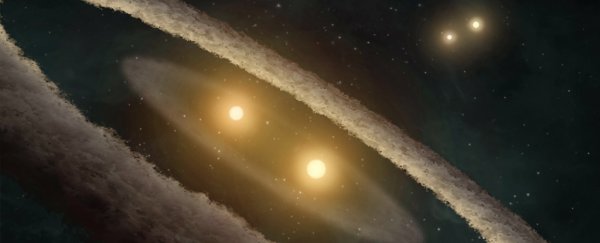A new model on how stars are formed has added weight to the hypothesis that most – if not all – stars are born in a litter with at least one sibling.
Our own star at the centre of the Solar System is probably no exception, and some astronomers suspect that the Sun's estranged twin might be the evil one, blaming it for the death of the dinosaurs.
After analysing data from a radio survey conducted on a dust cloud in the Perseus constellation, two researchers from UC Berkeley and the Harvard-Smithsonian Astrophysical Observatory have concluded all Sun-like stars are probably born with a companion.
"We ran a series of statistical models to see if we could account for the relative populations of young single stars and binaries of all separations in the Perseus molecular cloud, and the only model that could reproduce the data was one in which all stars form initially as wide binaries," said UC Berkeley astronomer Steven Stahler.
For years, astronomers have wondered if the large number of binary and triple systems of stars in our galaxy are created close to one another, or if they fall in together after they've formed.
The 'born together' hypothesis has been the favourite, and simulations developed in recent decades have shown almost all stars could be born as multiples that often spin away on their own.
Empirical evidence supporting these simulations has been limited, unfortunately, which makes this new work rather exciting.
"Our work is a step forward in understanding both how binaries form and also the role that binaries play in early stellar evolution," said Stahler.
As part of the VLA nascent disk and multiplicity survey (VANDAM for short), the researchers mapped the radio waves leaking out of a dense cocoon of dust about 600 light-years away that contained a whole nursery of young stars.
The VANDAM survey allowed for a census of stars younger than half a million years old called Class 0 stars – mere babies in star terms – and stars a little older between 500,000 years and 1 million years, called Class 1.
Combined with data on the shapes of the surrounding cloud of dust, the scientists found 45 lonely stars, 19 binary star systems, and a further five that contained more than two stars.
While their results predicted all stars were born as binaries, they amended their conclusion to take into account limitations in their model by saying most stars formed inside the dense cores of dust clouds are born with a partner.
"I think we have the strongest evidence to date for such an assertion," said Stahler.
Looking closely at the distances between the stars, the researchers found all binaries separated by a gap of 500 AU or more were Class 0 and lined up with the axis of the egg-shaped cloud surrounding them.
Class 1 stars, on the other hand, tended to be closer together at around 200 AU and weren't aligned with their 'egg's' axis.
"We don't yet know quite what it means, but it isn't random and must say something about the way wide binaries form," said Sarah Sadavoy from the Harvard-Smithsonian Astrophysical Observatory.
If most stars are born with a partner, where's ours?
A distance of 500 AU is roughly 0.008 light-years, or a bit under 3 light-days. To put it into perspective, Neptune is about 30 AU away, the Voyager 1 probe is currently just under 140 AU away, and the nearest known star Proxima Centauri is 268,770 AU away.
So if the Sun has a twin, it's almost certainly not easily visible in our neighbourhood.
But there is an hypothesis that our Sun has a dark twin that likes to swing by every now and then, and stir things up.
Given the name Nemesis, this theoretical trouble maker has been proposed as a reason behind an apparent 27-million-year cycle of extinctions on Earth, including the one that saw off most of the dinosaurs.
An astronomer from the University of California Berkeley named Richard Muller proposed 23 years ago that a red dwarf star 1.5 light-years away could periodically travel through the icy outer limits of our Solar System, stirring up material with its gravity, knocking a few more space boulders our way.
A dim passing star such as a brown dwarf could also explain other anomalies at the fringes of our Solar System, such as the odd, wide orbit of the dwarf planet Sedna.
There's no sign of Nemesis, but a long lost binary partner for our Sun could fit the bill.
"We are saying, yes, there probably was a Nemesis, a long time ago," said Stahler.
In which case, our Sun would have gathered the lion's share of dust and gas it seems, leaving its twin dark and stunted.
No wonder it's a little pissed off.
This research is currently on pre-print website, arXiv.org, and has been accepted for publication in an upcoming edition of Monthly Notices of the Royal Astronomical Society.
